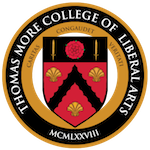
The Thomas More College of Liberal Arts
Six Manchester Street
Merrimack, NH 03054
Phone: (603) 880-8308
Fax: (603) 880-9280
Contact via email
Copyright © 2025 Thomas More College of Liberal Arts. All rights reserved.
God called man into existence, committing to him the craftsman’s task. Through his “artistic creativity” man appears more than ever “in the image of God”, and he accomplishes this task above all in shaping the wondrous “material” of his own humanity and then exercising creative dominion over the universe which surrounds him.
-Pope John Paul II, Letter to Artists
The traditional quadrivium is essentially the study of pattern, harmony, symmetry and order in nature and mathematics, viewed as a reflection of the Divine Order. Along with Church tradition, they provide the model for the rhythms and cycles of the liturgy. Christian culture, like classical culture before it, was patterned after this cosmic order, which provides the unifying principle that runs through every traditional discipline. Literature, art, music, architecture, philosophy—all of creation and potentially all human activity—are bound together by this common harmony and receive their fullest meaning in the Church’s liturgy.
This program teaches a deep understanding of these principles and their practical application through both lectures and workshops.
When we apprehend beauty we do so intuitively; an education that improves our ability to apprehend beauty also develops our intuition. All creativity, even that employed in business or scientific endeavors, is at its source intuitive. Furthermore, the creativity that an education in beauty stimulates and generates not just more ideas, but better ideas—better because they are more in harmony with the natural order. The recognition of beauty moves us to love what we see, and leaves us more inclined to serve God and our fellow man.
The Way of Beauty courses are taught by Katherine Yost. All students will learn to understand the principles and techniques that make classic works of art beautiful; those interested in creating their own works are welcome to join his optional evening classes in drawing and painting.
The course draws on works of pre-Christian classical thinkers, the Church Fathers (especially St. Augustine and Boethius) who established it as a Christian tradition, the developments of later medieval thinkers such as Aquinas and Bonaventure, and the writings of more recent figures such as popes John Paul II and Benedict XVI which place it in a modern context.
(2 semesters of 2 credits each semester)
A workshop aimed at the restoration of the students’ ability to perceive the beauty of order and the order of beauty. This aim is achieved through a year-long series of classes on drawing and aesthetics as well as a practical and theoretical approach to traditional Catholic music. Privilege of place is given to the iconographic tradition and to Gregorian chant.
(3 credits during second year of studies)
An introduction to the patrimony of ancient and Christian art and architecture, with extensive site visits in Rome, Lazio, Umbria, and Tuscany. The ‘texts’ will principally be the buildings, sculptures, and paintings themselves, but students will also be asked to reflect upon the nature and purpose of the arts through reading selections from Vitruvius, St. John of Damascus, Abbot Suger, Alberti, Josef Pieper, and John Paul II.

The Thomas More College of Liberal Arts
Six Manchester Street
Merrimack, NH 03054
Phone: (603) 880-8308
Fax: (603) 880-9280
Contact via email
Copyright © 2025 Thomas More College of Liberal Arts. All rights reserved.